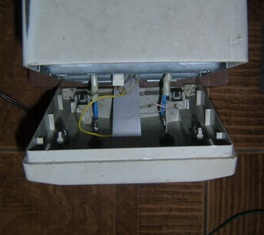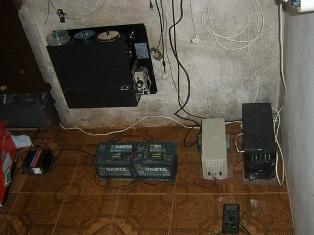Categories: Sharing experience, Electrician Secrets, Electrician at home
Number of views: 196346
Comments on the article: 16
Powerful do-it-yourself uninterruptible power supply
 We make a powerful uninterruptible power supply based on a standard UPS by connecting two KAMAZ batteries to it. We also do automatic ventilation when switching to offline mode.
We make a powerful uninterruptible power supply based on a standard UPS by connecting two KAMAZ batteries to it. We also do automatic ventilation when switching to offline mode.
Such is the reality that Russian power grids force consumers themselves to take care of the stability of the electricity they receive. In our case, it is necessary to solve two important problems: a large voltage drop (typical for the hot / cold season, when the air conditioners / electric heaters turn on) and a complete blackout (“knocking out” of machines, accidents at substations, etc.).
If the first problem is easily solved by installing an autotransformer, which allows to obtain a stable voltage of 220 volts at the output, the second requires the organization of an uninterruptible power system, designed for a long period of battery life.
Organize uninterrupted supply of a country house or a garage using modernization of computer UPS (uninterruptible power supply). After two years of operation in any UPS, internal batteries degrade. An uninterruptible power supply with non-working batteries was repeatedly observed on the radio market at a symbolic price of 1000 rubles.
For a long battery life, an uninterruptible power supply must be connected to high-capacity batteries. The best option would be starter batteries from KAMAZ - 140 Ah batteries. Since most powerful uninterruptible power supplies use batteries with a total voltage of 24 volts, then we need a couple of batteries connected in series. The state of your batteries will determine the duration of the autonomous power supply.
First of all, we take out and throw out the faulty battery. For the convenience of connecting an external high-capacity battery, we need to make contact clips (preferably red and black colors, indicating plus and minus, respectively). To do this, we make two holes on the front panel of the uninterruptible power supply unit, fix the contact clips and solder the wires to them, which fit the internal battery.
Continuous operation in the state of converting battery energy to a voltage of 220 volts is accompanied by large heating. To prevent premature failure, it was decided to install two ordinary fans with a size of 80x80x25 mm on the ventilation grill.
Fans are connected in series. To start the fans in conversion mode, we use an LED that indicates the operation of the uninterruptible power supply from the battery. We solder the leads of the LED to the windings of a small relay. We solder the wire from the incoming plus of our battery to one of the relay contacts. To the second - the free red wire of the fan. Solder the free black wire of the fan to the incoming minus of the battery.
All! Now, when the uninterruptible power supply enters the operating mode from the battery, cooling will automatically turn on.
Read also: How to choose a UPS for the boiler
See also at bgv.electricianexp.com
:



